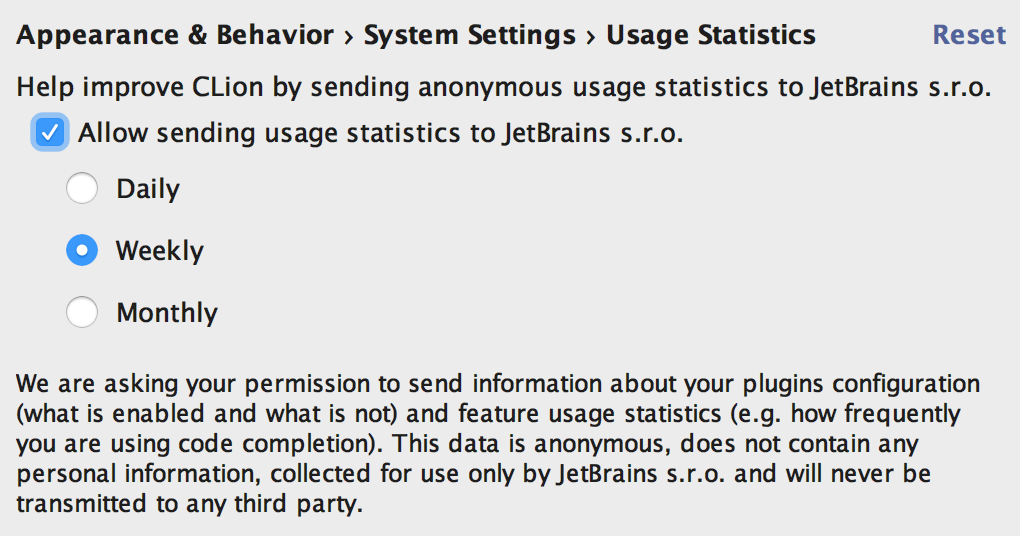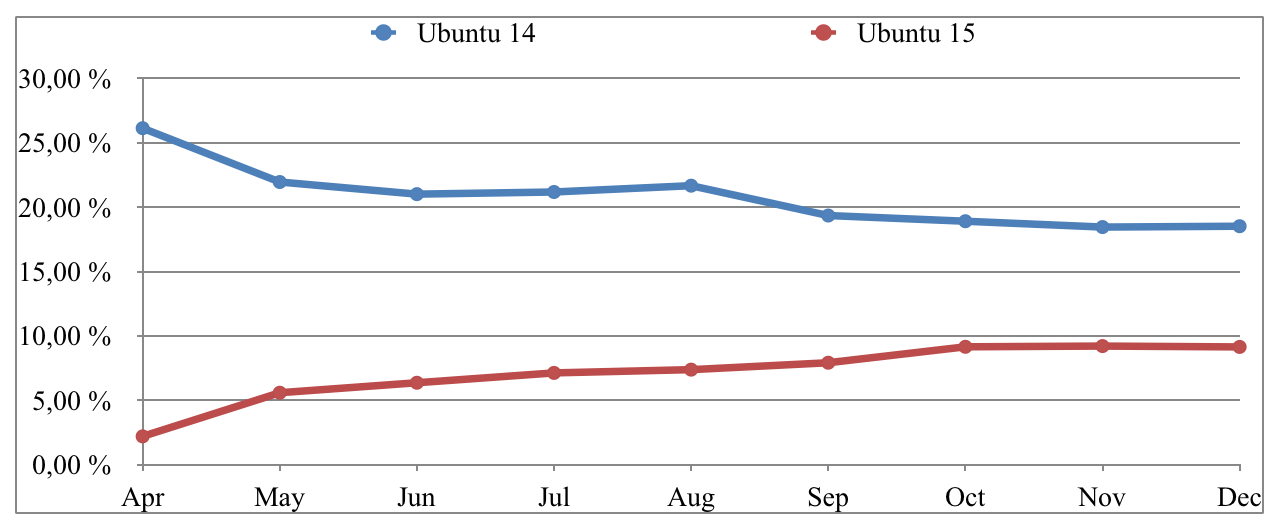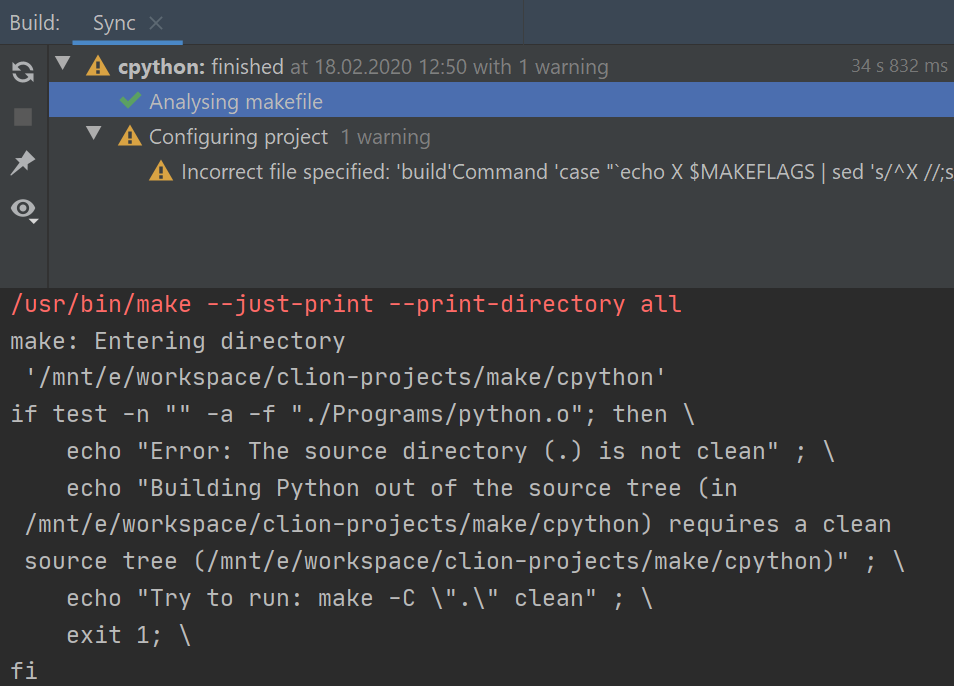CLion in 2015: A Review of Feature Usage
Hi everyone,
CLion IDE was released to the public in April 2015, and now may be a good time to look back and see how things have developed (no pun intended).
We published a similar overview within six weeks of the launch of the first public CLion EAP (Early Access Program). At that time we were wondering how the product evaluation was going and which features attracted the community’s attention the most.
Today we are interested in gaining a more in-depth understanding of how our customers are using the product. What is their environment, which features do they use most often, what plugins do they install?
EAP builds are still helping us make the product better by providing early feedback channels, and the usage statistics is invaluable in making decisions about product development, building roadmaps and setting feature priorities.
Where do the statistics come from?
At the end of 2015, CLion had 45K unique active users per month, which sounds really fantastic to us. Approximately 16% of these users agreed to send us their anonymous feature usage statistics.
We want to give a huge thanks to everyone helping us understand how you use the product. And if you’re not sharing your statistics with us yet but would like to, please follow these steps:
- Go to Settings/Preferences
- Open Appearance & Behavior | System Settings | Usage Statistics
- Select how often you want statistics to be sent:

Thanks to about 8K of our customers, we now have some understanding of what features, plugins and platforms were used most often in 2015. Let’s take a look and keep in mind that all the percentage below were calculated based on the data reported to us by those 16% (though we do believe the trends are representative of all customers as a whole). We tend to focus on per-month statistics, so all the counters are calculated as unique users reports per month.
Platforms and toolchains
It is no surprise that CLion is more popular on Linux than on either Windows or OS X. It has been a general trend since the very first Public EAP build, and is confirmed by the number of downloads from our site. The usage statistics says that around 40% are using CLion on Linux, and the rest is shared equally between OS X and Windows.
Some more detailed analysis shows us that:
- In 2015 Ubuntu 14 was dominating as the main Linux distribution among CLion users. However, it looks like Ubuntu 15 is catching up:

- With Windows and OS X it’s quite an expected trend when the latest OS version dominates as soon as it’s available. Though OS X users transition is much quicker.
- 94% of all the users who reported the stat, use bundled CMake version. Currently it’s 3.4.0. The latest 3.4.2 will come with the upcoming CLion 1.5 EAP.
- On Windows most popular MinGW version is 3.21 (~10% of all the reporters), to our surprise MinGW-w64 is not that popular at all. As for the Cygwin there is a huge variety of versions used by our users with Cygwin 2.2.1 leading in autumn and Cygwin 2.3.1 reaching it in the end of the year.
Productivity features
Here we come to the most interesting part – how our users actually use the IDE features for code editing, navigation, refactorings and so on.
Navigation
The top 4 features for navigating across projects in 2015 were:
- Go to declaration (
Ctrl+Bon Linux/Windows,⌘Bon OS X) – up to 60% of users are using it. - View types hierarchy (
Ctrl+H) – used by up to 40%. - Go to class (
Ctrl+Non Linux/Windows,⌘Oon OS X) – was tried at least once by up to 20%. - View file structure (
Ctrl+F12on Linux/Windows,⌘F12on OS X) – 7% have used it.
As a general trend for all four actions, the usage of each one grew steadily throughout the year.
If you’d like to learn more about these and other navigation features, see our blog post about Search and Navigation in CLion.
Code assistance
When you are writing code, IDE can assist in many ways by providing you with various code generation actions, as well as different views for additional insight into your code. The four most popular features here included:
- View parameter info (
Ctrl+Pon Linux/Windows,⌘Pon OS X) was used by 60-65% of the users in 2015. - Quick-fix (
Alt+Enter) usage has grown up to 50% during this year. - Generate action (
Alt+Inserton Linux/Windows,⌘Non OS X) usage has reached nearly 30%. - Quick Documentation (
Ctrl+Qon Linux/Windows,F1on OS X) is used by about 15%.
Similar to navigation actions, the usage of these code assistances features saw continuous growth last fall.
Refactorings
Refactorings are an essential part of all JetBrains IDEs, and we were eager to see what’s trending here. Once again, the Rename refactoring (Shift+F6) is the runaway leader, being used by nearly 50% by the end of 2015. The runner-up refactoring was Extract Function (Ctrl+Alt+M on Windows/Linux, ⌥⌘M on OS X) with just 7-8%.
Maybe it’s a good time for you to try Change Signature, Inline or Pull Members Up/Down through the hierarchy refactorings? If you’re interested in the full list of refactorings and a short demo about them, please, take a look at this blog post.
Plugins
There are quite a few plugins bundled with CLion, meaning they are available out-of-the-box, including:
- YAML support
- JavaScript support
- LESS and SASS support
- CoffeeScript support
- and others
Starting with the 1.5 EAP, the following plugins join the club:
- Remote Host Access
- PyCharm Community Edition (Python support)
- Swift support (available as a separate package for now, so you need to download and install it separately, at least during the EAP)
We also have an open repository where you can find hundreds of plugins created by both JetBrains team and 3rd-party developers. It’s interesting to see how actively our users install some of them, for example:
- IdeaVim (vim emulation mode and vim key bindings) ~11%
- BashSupport ~7%
- GLSL Support (support for the OpenGL Shading Language) ~ 2.4%
- Go language support <1%
- CLion-cpplint (running cpplint on the fly when you are editing C++ source code) <1%
And a few more numbers
Finally, let us share some other interesting facts that we’ve gleaned from the feature usage statistics:
- Nearly 30% of all users click the ‘Next’ button in the Tip of the Day dialog. We are really happy to see that they’ve managed to catch your attention! By the way, if you follow our twitter (@clion_ide), take note of posts with the #TipoftheDay hashtag that we run there once in a while. For example, one of the recent tips was about the code generation feature called Surround With.
- Google code style is selected nearly twice as often as any other from the predefined code styles list.
- Git is nearly 10 times more popular than any other VCS used with CLion.
That’s about it. Once again, we thank those who have reported their statistics to us, and wish you all productive coding in C and C++ with CLion in 2016!
The CLion Team
JetBrains
The Drive to Develop
Subscribe to CLion Blog updates



